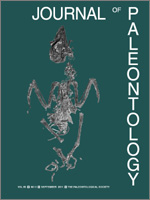A single large colony (20 cm) of Rhombopora blakei n. sp. from the Hook Head Formation of Ireland (Tournaisian Stage, Mississippian) permits an analysis of within-colony variation associated with environmental change at a calendar scale (days to decades). Morphometric data for three external characters—apertures spacing along a branch and diagonal to a branch as well as lateral zooecial spacing—were collected as growth series (16–30 generations) from 13 segments within the colony. ANOVA, post-hoc means testing and graphical analysis of standardized data revealed nearest neighbor effects at the zooecial level and non-random distribution of variances across the colony. Parametric tests for sequential nonrandomness revealed cyclic variation through growth transects at three levels (23.3, 9.4 and 5.3 generations). Comparisons to growth rates of modern bryozoans suggests that the longer-term cycles are annual and that the shortest cycles may be related to lunar tidal cycles. The exceptional size and preservation of this single specimen, which is a new species of rhabdomesine Bryozoa, reinforces the importance of collecting individual morphological measurements from randomly selected and widely spaced parts of a colony for taxonomic, evolutionary and ecological applications.
How to translate text using browser tools
1 September 2011
Calendar Scale, Environmental Variation Preserved in the Skeletal Phenotype of a Fossil Bryozoan (Rhombopora blakei n. sp.), from the Mississippian of Ireland
Steven J. Hageman,
Patrick N. Wyse Jackson,
Aaron R. Abernethy,
Margret Steinthorsdottir
ACCESS THE FULL ARTICLE

Journal of Paleontology
Vol. 85 • No. 5
September 2011
Vol. 85 • No. 5
September 2011




